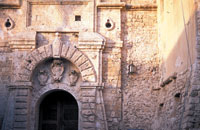
Paradoxically the attraction of Libya is that it has been unattractive for so long… a closed destination for the average tourist and particularly the travel agent.
Today, some tour operators have started promoting this fascinating North African country and now is the time to start exploring before too many tourists start beating a track to its shores.
The smell of a combination of orange and leather still evoke for me my first visit to the souk in Tripoli. We still own a leather safari chair, which cost us next to nothing, as a chubby thobed market trader bargained with me through three cups of tea and then insisted on giving me a cushion for the chair as well as carrying the fold-away chair to my car.
Tripoli, once known as ‘The White Bride of the Mediterranean’, is the major city of Libya, a seaport dominated by the huge Red Castle, Assai Al Hamra, a vast complex of courtyards, alleys and a souk, and leading the way to the coastal cornice. Tripoli is a city of monuments, palm trees, orange trees, where visitors can shop for carpets, gold and silver jewellery, leather goods and pottery.
Libya’s number two city is Benghazi, a long but interesting drive eastward along the coastal road. Located on the eastern edge of the Gulf of Sirt, Benghazi is a major commercial centre. The main market, the Souq Al Jreed, offers a multitude of clothes and household wares.
In both cities, in fact in all the villages and towns of Libya, you will find very hospitable people, who will welcome you as friends to their country.
The Roman and Greek ruins in Libya are some of the best archaeological sites in Africa, much more fascinating than Carthage in Tunisia, which has so little left of the past, and whether you clamber over the ruins or swim under them, the ancient ports of Leptis Magna and Sabratha are worth dragging your family away from the sunny beaches.
Years ago, on my first visit to Sabratha, I found a Roman coin on a footpath which I imagined was dropped by a centurion, as he was fastening his sandals, at the edge of the amphitheatre, which is still there 2,000 years later.
Today, there is a museum with a big collection of coins and statues picked up, I am sure, by archaeologists digging on the site. We know from the public baths that the Romans were not shy for there is a row of toilets side by side flushed no doubt by the Mediterranean.
But it is Leptis Magna’s awe-inspiring architecture, which will take your breath away. Once it was a Phoenician port and now some of the more interesting sculptures and arches lie below the sea. The sands of time buried the city for nearly a thousand years until Leptis Magna was rediscovered in the 20th century.
Despite the passage of time, you will find most of the ruins worth exploring like the archway built in honour of the emperor Septimus Severus and an amphitheatre, which used to be the venue for chariot races, plus mosaics and a museum near the entrance to the site, a must for history buffs. The Hadrianic Baths are the largest-ever found outside Rome as well as a pair of giant forums designed after the imperial forum in Rome.
The third major city in Libya is Cyrene, some 115 miles north east of Benghazi, situated on a hill, which overlooks the Mediterranean. This is a world heritage site, the best preserved ancient Greek city in North Africa.
You may find yourself alone with temples and tombs, for the charm of Cyrene is essentially that it is still virtually untouched since its re-discovery in the 20th century.
Libya is a country of contrasts and contradictions. In the south lies the endless Sahara sands with the famous ghiblis bringing the hot desert winds to the very edge of the Mediterranean, then there is the lush Jebel Akhdar in the east of the country, strangely green for a desert country.
Libya is also an intriguing new destination with cities searching for their role in the 21st century, sightseeing attractions lost in a time-wrap waiting for you to discover them, a sun-blessed land with a population of more than five million friendly citizens.
